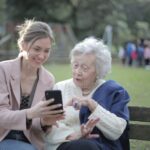Helping seniors learn new technology is more important than ever. In our modern times, we’re seeing the highest rate of aged people in human history. In the 21st century, we’re going to see the fastest growth ever. According to a recent study by the UN, it’s not a temporary change. The study reveals how our world population aged from 1950 to 2050. And this data is not for one country, it’s a global phenomenon.
Aging populations worldwide come with unique economic and social challenges, and different people find ways to face these challenges. Another study reveals some serious statistics, which shows that 3 in 5 seniors somehow suffer from a long-term physical condition, 1 in 3 suffers from short-term physical conditions. In contrast, 1 in 4 suffers from memory problems.
How Technology Can Help A Senior’s Life?
We have seen a huge rise in technological developments over the last 20 years or so. For example, access to the internet has opened so many ways for people of all ages, from all around the world, and makes it a lot easier for everyone to learn, work, and shop.
If we talked about young people, they find it easier to use modern technology as they grew up using it. On the flip side, older adults or seniors are generally less inclined and connected to modern technology. Many older people don’t see the opportunity how technology could benefit them, especially if they’ve never used a smartphone or familiar with the internet in any way. So, helping seniors learn new technology can address this situation.
1. Identify At-Risk Seniors Early
Today, several social services organizations and agencies use a reactive model to help people. In a nutshell, someone must inform the organization that a senior person or any individual needs help. This model means that help will be given to those aware that they’re eligible for help and capable of asking for it. Still, many people at risk don’t meet these conditions.
To make this process easier, we can use Big Data to shift to an effective and predictive model of helping people instead. This data can be used to predict which people are likely to be at high-risk and which are on early-stage, and social services organizations or agencies can proactively reach out to them.
2. Help Seniors Be More Self-Sufficient
Currently, over 90% of seniors in the U.S alone desire to live in their own homes. Technology makes this possible. Even if they don’t suffer from health problems or any other condition. Many older adults suffer from mobility issues and find it difficult to do simple things like getting up to turn on a light. However, with the help of smart home technology, we can help senior people with simple tools to make a small and meaningful difference in their daily life.
Let’s talk about some minor changes to a home that make aging in place easier. Maybe they can open a door by using their mobile device. Or use a modern sink that comes with sensor technology to ease the turning on and off process, or lights can turn on or off when motion is detected. Using these simple technology improvements, you can help seniors prevent falls when they get up unsteadily or have to go somewhere quickly.
3. Bring Medical Care Into Their Own Homes
A trip to the doctor or consultant who requires much-needed care can be a big undertaking for seniors. Rather than taking a difficult trip, technology can help bring doctors into their homes. An older article from Forbes estimated that by 2018 nearly 22 million households would use some virtual care platform for medical care. In 2023, you can expect how that number would’ve grown, especially due to the pandemic.
Many medical centers and even consultants now offer telehealth services to let patients contact them through video calls or just a simple audio call. Digital healthcare systems can also use questionnaires and facial-scanning technology to help diagnose a patient more easily. These tools can also track several health patterns and help a carer or family member track changes in health patterns.
4. Utilizing Fitness Devices For Better Diet and Body Shape
As we all know, being healthy and fit is essential for people of all ages, but it can especially benefit seniors. Modern health wearables can help seniors monitor their daily activity and track their fitness goals and health progress. Most fitness trackers are worn around the wrist and help you monitor your activity throughout the day.
Fitness devices can track the following and more:
- Daily steps
- Body composition
- Calories burned
- Blood pressure
- Heart rate
- Sleeping patterns.
Different types of wearable technology devices may have features like GPS for location tracking, and BlueTooth allowing you to connect your mobile device for better management. Some are waterproof to help track your swimming exercise, etc.
5. Using Health and Mobility Devices
Now, this can be a completely new thing for some people. By using stairlifts, mobility scooters, and electric wheelchairs, seniors can live their life from a new perspective, and a lot of opportunities can be opened for those who are disabled. It can help them play different sports and be more efficient in daily life tasks.
On the flip side, health monitoring can also be very reassuring for seniors. For example, seniors who have suffered from any heart problem can have blood pressure or heart rate monitors in their home. This technology can take blood pressure and heart rate measurements so that you, your family, or your carer can check on your condition anytime they want.
Here are some other great examples of mobility technology for senior people:
- Stairlifts – Stairlifts allow you to get up and down the stairs without the risk of falling and make the stair process easier for seniors. Installing a stairlift at home is a great way to stay safe and make your life easier.
- Mobility Scooters – If you face problems while walking long distances, mobility scooters are a great choice. A mobility scooter is ideal if you have osteoporosis, arthritis, or Paget’s disease of the bone. It comes in different models containing several amazing features like a basket to store your shopping bags and help you move your basic stuff.
- Electric Wheelchairs – Just like mobility scooters, you can purchase an electric wheelchair as an alternative to move around. By having an electric wheelchair, you don’t need to waste your energy wheeling yourself, nor require somebody to push you. This gives you more independence and freedom of doing anything at any time.
6. Keep Them Feeling Like Part of a Community
The University of California San Francisco conducted a study in which they found that 43% of senior people feel lonely daily. If we look more at this percentage, we’ll find another point that says that 59% of these seniors have a greater risk of decline and a 45% at risk of death
But, there’s a solution for it. By using modern socializing apps and social media, seniors can connect to their loved ones anytime and anywhere. Also, playing video games and connecting with other seniors people online. It’ll help them be a part of their aged-group community and can connect to more senior people online.
Check out our guide to the best computers to help seniors stay connected.
Moving Fast
Today, technology is evolving too fast compared to other industries. In this fast-growing world, people are too busy and don’t have time for seniors. But technology has helped them too. Using these tips, you can have an independent life even in your old age and make your own choices rather than depending on others.






